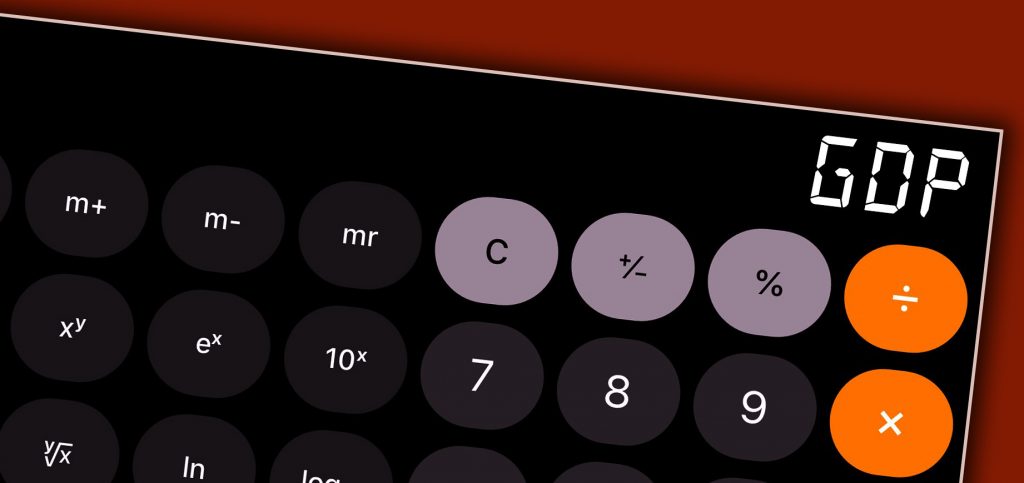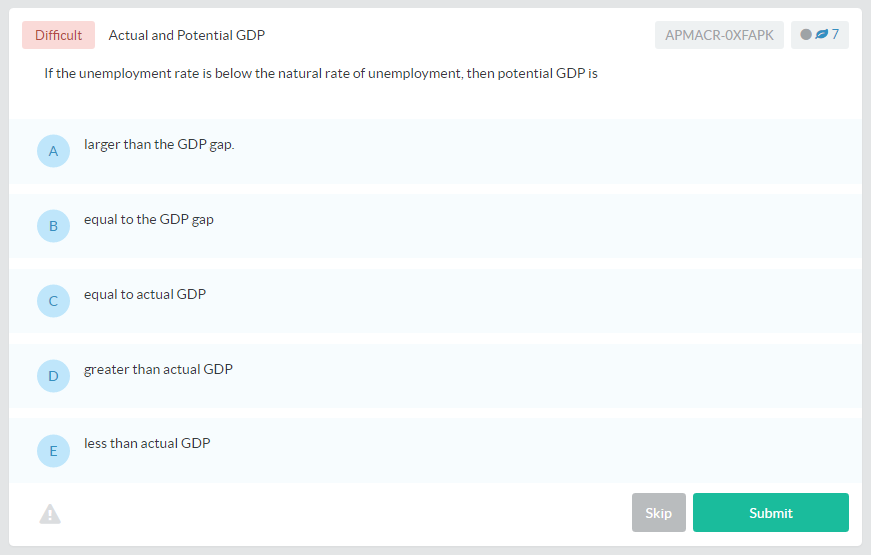Below is a cheat sheet to help you calculate nominal GDP and real GDP. Before we get started with our calculations, let’s first review what GDP is.
What Is GDP?

GDP, or Gross Domestic Product, is that term economists use to determine how well or poorly an economy is doing. That’s easy enough. It is the total combined monetary value of a society’s goods and services produced within a given period of time. So if you take all of the companies and individuals who produce goods and services, add all of their monetary value up, you get your GDP. Because there are literally millions of companies and individuals in the U.S., Gross Domestic Product is usually in the trillions of dollars. Movies like Deadpool and Pitch Perfect add to the GDP because they generate so many ticket sales; companies like SnapChat add to the GDP; food chains like Starbucks and Chipotle add to it; individuals like Taylor Swift and your parents; and lots of others in every industry and sector you can think of contribute to our GDP. But the bottom line is the more these companies and individuals produce in a given period of time, the more jobs there will be and the higher wages there will be. In everyday terms, that means more money in people’s pockets, more trips to the mall to buy the stuff you like, and more trips to the theater to enjoy a show.
How to Calculate GDP vs. Real GDP
So what is the method to calculate GDP? It’s really quite simple. GDP can be determined by the formula below. This formula works every time, which is why they call it a formula. But please note, when most people talk about GDP, they are talking about “nominal GDP,” or GDP measured in a specific period of time (this differs from real GDP, which we will get to later). For large, “developed economies” (i.e., the U.S., Canada, and Europe), GDP numbers will usually be in the trillions. For smaller, “developing economies” (i.e., economies in Africa, Latin America, or some parts of Asia), GDP numbers will often be in the billions. To put this in context, if you ever saw the Wolf of Wall Street movie, A list actor Leonardo Dicaprio made $25 million from the movie whereas B list star Jonah Hill only made $60k from it. The same is true for developed vs developing economies; some nations’ GDPs are a lot bigger than others.
The way economists determine the monetary value of what companies and individuals produce is by looking at the total quantity of goods or services produced by that person or individual and then they multiply it by the price of those goods or services.
Total Revenue=Price (P) X Quantity (Q)
So let’s say we were trying to calculate the total monetary value, or total revenue, of the video game developer Rocksteady Studios last year, which produces the “Batman: Arkham Knight” video game. To calculate the total monetary value of Rocksteady Studios–or total revenue–we would need to know the total number of games they produced in 2015 (in this case, 5,000,000) and the price of those games ($29.99).
Total Revenue= $29.99 (P) x 5,000,000 (Q)
Which equals a grand total of $149,950,000 (plus tax, of course).
When you take total revenue of not only Rocksteady Studios, but you also take all of the other people and firms’ total revenue (in this case, in the UK, which is where Rocksteady is based), you will begin to get an idea for how much collective monetary value private companies and individuals are producing. It’s important to note, though, that this does not get you your total GDP figures. It’s just an illustration for how total revenue is calculated, which is only one part of the GDP game.
To calculate actual GDP, there are a couple of approaches. We’ll look at them below. We’ll also look at how to calculate “Real GDP.”
One way to determine GDP is the “EXPENDITURE APPROACH,” which measures what households spend:
GDP=C + I + G + (X-M).
And here’s what the formula actually stands for:
GDP = private consumption (C) + gross investment (I) + government spending (G) + (exports – imports).
A way to more easily remember this is…
GDP= All the stuff everyone buys + investments made in companies like Uber + Obama’s big spending + (the stuff we buy overseas – the stuff people from overseas buy from us).
We’ll get to an example of this in a second, but before we do let’s talk about the second way GDP is typically calculated.
The second way GDP is calculated is the INCOME APPROACH, which measures what households earned:
GDP= W+ I+ R + P + IBT + CCA.
In other words, it is…
GDP=wages + interest income + rent + profits + indirect business taxes + capital consumption allowance
An easier way to remember this is to think about it this way:
GDP=how much money everyone earns from their jobs + money we earn from banks + our rent + our profits from our businesses + taxes to the government + depreciation.
Sample GDP Calculations
I know this seems like a lot to remember for the test especially given everything else they are testing you on, but you got this. Here are a few examples we can work through to help you become a pro at calculating GDP.
Sample Example 1:
Daytime TV star Ellen has decided to buy a tiny country and re-name it “Dance Land,” after her favorite pastime (dancing). She has also declared herself Emperor in the Highest. All because she can. Emperor Ellen has just hired you as the High Priest of the Economy for “Dance Land.” Dance Land is mainly catering to tourism, where most people work as comedians, dancers, or at resorts. Their private production generates $50,655,303 annually. She has also convinced Seth Rogen and Steve Carell to invest $10,000,000 in creating a sequel to Dance Land’s chief export, Dance Dance Revolution, which generates $1.2B in foreign sales. Dance Land’s imports are $35,000,000 annually. Emperor Ellen doesn’t like imports–she is quite jealous–and wants more homemade items. She has decided to spend $25,000,000 to build new schools, roads, and manufacturing plants for the country to increase Dance Land’s ability to be more productive. As High Priest of the Economy, Emperor Ellen needs you to calculate her country’s GDP. How do you go about doing it?
Well, all we have to do is use the GDP formula–which, again, is why they call it a formula–and we can arrive at our answer.
Here’s what we know:
Private consumption=$50,655,303
Gross Investment=$10,000,000
Government Spending=$25,000,000
Imports=$35,000,000
Exports=$1, 200,000
So when we plug our GDP formula in, we get…
GDP=C + I + G + (X-M).
GDP=$50,655,303 + $10,000,000 + $25,000,000 + ($1,200.000-$35,000,000)
=$1, 202, 155.33
Sample Example 2:
You have just been hired by the Bureau of Economic Analysis in the U.S. Department of Commerce. Your chief job is to be responsible for determining the GDP in the United States. The President, U.S. Congress, TV shows, and even your high school AP® economics teacher will be reading your calculation and report, so the pressure is on. If you get it wrong you will probably be disowned by your family and friends and cause a major financial collapse, bringing suffering to millions, especially pets and small children. So be very careful in your calculations. Your boss has asked you to determine GDP, but instead of using the spending approach, they want you to use the income approach. How do you go about doing it?
The first thing you will need to remember is what is the formula for calculating GDP (using an income perspective):
GDP= W+ I+ R + P + IBT + CCA.
The next thing you will need is the data. On the AP® test, all of the data will be provided for you. Just plug and play your formula and you will be all set–it’s simple addition.
BUT there is a catch. And the catch is that measuring GDP with only these two approaches can sometimes be misleading if you are trying to compare current GDP with past GDP or trying to compare one country’s GDP with another country’s GDP. When this happens, you will have to calculate what is called “Real GDP.” Based on its name alone, Real GDP is just trying to keep it real, or to more accurately measure an economy given that inflation and deflation impact prices from year to year. Real GDP reports as if prices never went up (inflation) or down (deflation).
Here’s How We Calculate Real GDP

Luckily, there is a simple formula for this, too. To calculate real GDP, it’s nominal GDP (GDP not adjusted for inflation for whatever year you are using as a base year, or comparison year) divided by the deflator (the measurement of inflation), or R=N/D. So, for example, if prices rose 2.5% since the base year, the deflator is 1.025. What this means is that if you nominal GDP was ($100,000,000), the real GDP would be $97,500,000 (or 10,000,000/1.025=$97,500,00).
How You Will be Tested on GDP on the AP® Macroeconomics Test
You will have a Multiple Choice Section (Section 1) and a Free Response Question (Section 2). The first part of the test will last for 70 minutes and will account for 66% of your score. The second part of the test will be 60 minutes and will account for the remainder of your score. For the multiple choice section, you could be asked questions like this:
In a certain year, nominal gross domestic product grew by 6 percent. The inflation rate was 3 percent. Real gross domestic product for this year was
A. Grew by 6 percent
B. Remained constant
C. Grew by 12 percent
D. Grew by 3 percent
And the answer is D. Nominal GDP is the rate at which real GDP increases. To find real GDP growth (growth that accounts for inflation), subtract the inflation rate from the nominal GDP growth rate.
For the Free Response part of the exam, you will always have 3 questions. Question 1 will always be the long FRQ and I would recommend spending 25 minutes on it. It is best to draw your graphs to help you better and more quickly figure out the answers (for this question and each question thereafter). Always remember, too: do not be intimidated by the content (i.e., the specific information they ask you to solve), just use the formulas you have studied in class and in your test prep to plug and play. And if all else fails, use your logic. You are like a detective when solving the FRQ section. But be sure to be CLEAR with your responses and write them CLEARLY (you can get docked for not making your answer known and for unintelligible handwriting).
Just go into the test knowing that you have prepared as much as you can and use your intelligence and logic to think through the multiple choice and FRQ and you will be just fine.
Wrapping Up Calculating GDP for AP® Macroeconomics
So as you can see, Gross Domestic Product is arguably the most important concept in all of macroeconomics. There are several ways to calculate it (the expenditure approach and the income approach) and several ways to measure it (e.g. Nominal GDP vs. Real GDP).
Let’s put everything into practice. Try this AP® Macroeconomics practice question:
Looking for more AP® Macroeconomics practice?
Check out our other articles on AP® Macroeconomics.
You can also find thousands of practice questions on Albert.io. Albert.io lets you customize your learning experience to target practice where you need the most help. We’ll give you challenging practice questions to help you achieve mastery of AP Macroeconomics.
Start practicing here.
Are you a teacher or administrator interested in boosting AP Macroeconomics student outcomes?
Learn more about our school licenses here.









